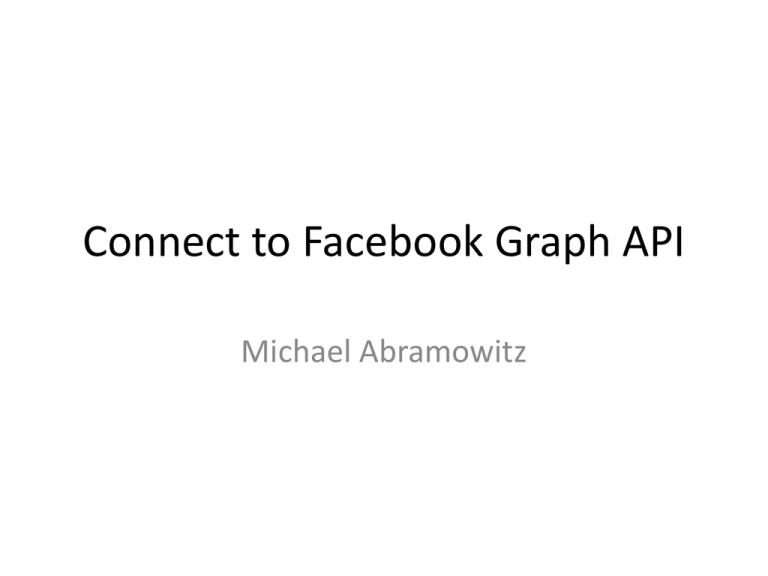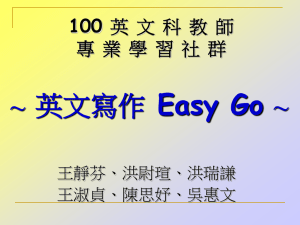Connect to Facebook Graph API
advertisement

Connect to Facebook Graph API
Michael Abramowitz
Reasons To Use Facebook API
• Social Design
–
–
•
Social Design is a way of thinking about product design that puts social experiences at the core.
Create these social experiences with the features available on Facebook Platform.
Build “inside out” or “outside in”
According to Facebook:
–
–
–
–
Utilize the existing robust Facebook community to define new conversations and let users continue
to build their identities further
Utilizing Community
• Communities feel familiar, relevant and trusted by default. Surface users' interests and their
friends in your app to create personalized user experiences
Building Conversation.
• Conversations are how people express their identities to communities and how they receive
feedback from them. Build experiences that give people the power to connect and share.
– Listening" : Displaying personalized content, social context and user activity
– "Speaking" : Making it easy for users to talk, share, give feedback and engage
Curating Identity
• Users share and interact with others because self expression feels good and rewarding. Help
them learn more about themselves and curate their identity.
OAuth
•
•
•
•
•
•
•
•
IETF RFC 5849, The OAuth Protocol, defines OAuth as12:
– ...a method for clients to access server resources on behalf of a resource owner (such as a different
client or an end-user). It also provides a process for end-users to authorize third-party access to their
server resources without sharing their credentials (typically, a username and password pair), using
user-agent redirections.
Client: HTTP Server making OAuth-authenticated requests (YourAndroidApp)
Server: HTTP Server receiving and responding to OAuth-authenticated requests (Facebook)
Protected Resource: Access-restricted resource that can be obtained from the Server using Oauthauthenticated request (Facebook Graph Data)
Resource-Owner: Entity capably of accessing and controlling protected resources by using credentials to
authenticate with the server (YourAndroidApp User with Facebook Account)
Client Credentials: used to identify and authenticate client (YourAndroidApp credentials at Facebook ;
Facebook API Key and Secret Key)
Temporary Credentials: credentials obtained using the authorization request of resource owner
(intermediation credentials of YourAndroidApp @ Facebook)
Token: unique identifier issued by the server and used by client to associate authentication requests with
the resource owner whose authentication is requested or has been obtained (YourAndroidApp permission
to use Facebook on behalf of User)
Oauth
Oauth on Facebook from Android
http://developers.facebook.com/docs/mobile/androi
d/build/
•
Register App and get App ID and APP Secret
•
Include in creation of Facebook object
•
App id is included when creating the Facebook
Object
•
Facebook fb = new Facebook(“YOUR_APP_ID”);
•
User is Redirected To Login Portal
– User must provide authorizations
– If Facebook is installed on device and user
is logged in
• Do not need to enter credentials
SSO and Permissions
•
By default, the user is asked to authorize the app to
access basic information that is available publicly or by
default on Facebook. If your app needs more than this
basic information to function, you must request specific
permissions from the user.
•
Just list Permissioning Enumerations in String Array on
Authorize call
http://developers.facebook.com/docs/authentication/permissi
ons/
•
Grants Access to other Portions of Graph API
Example:
facebook.authorize(this, new String[] { "email", "publish_checkins" }, new
DialogListener() {
@Override
public void onComplete(Bundle values) {}
@Override public void onFacebookError(FacebookError error) {}
@Override public void onError(DialogError e) {}
@Override public void onCancel() {} } );
•
SSO allosw
SSO
•
Single Sign-On allows user to authorize your app without typing their facebook username and password. This is
accomplished by sharing intent with the Facebook app. If the user has already installed and authorized the
facebook app, your app can leverage the Facebook app authentication via Single Sign On.
public class MyGreatActivity extends Activity {
Facebook facebook = new Facebook("YOUR_APP_ID");
@Override
public void onCreate(Bundle savedInstanceState) {
super.onCreate(savedInstanceState);
setContentView(R.layout.main);
facebook.authorize(this, new DialogListener() {
@Override
public void onComplete(Bundle values) {}
@Override
public void onFacebookError(FacebookError error) {}
@Override
public void onError(DialogError e) {}
@Override
public void onCancel() {} }); }
@Override
public void onActivityResult(int requestCode, int resultCode, Intent data) {
super.onActivityResult(requestCode, resultCode, data);
facebook.authorizeCallback(requestCode, resultCode, data);
}
}
Store acces tokens in prefence bundles
Android SDK Documentation
AsyncFacebookRunner
• http://developers.facebook.com/docs/reference/androidsdk/
• Use AsyncFacebookRunner
– AsyncFacebookRunner(Facebook facebook);
– request(String graphPath, Bundle parameters, RequestListener
listener);
• The Asynchronous API request methods which returns immediately
without blocking the calling thread. These are defined in
AsyncFacebookRunner.java. This is necessary when accessing the
API in the UI thread, for instance. The request response is returned
to the caller via the RequestListener interface, which the developer
must implement.
• The RequestListener Interface provides the callback methods for
asynchronous request methods. These are defined in
AsyncFacebookRunner.java.
Make Calls with AsyncRunner and
RequestListener
•
AsyncRunner
– myAsyncRunner.request(“path”, parameters, new requestListener(){
@Override
public void onComplete(String values) {}
@Override
public void onFacebookError(FacebookError error) {}
@Override
public void onError(DialogError e) {}
@Override
public void onCancel() {} }); }
}








